I've always had a fascination with imagery outside of the visible spectrum whether near UV / near IR microscopy or conventional near IR photography. In May 2010 I converted my aging, near valueless Sony S75 consumer digicam for NIR work and was pleasantly surprised that all functions still worked a treat when reassembled, see my earlier Micscape article.
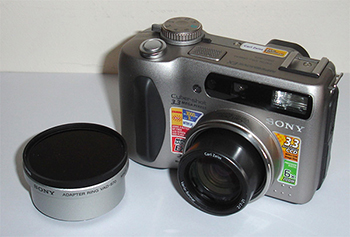
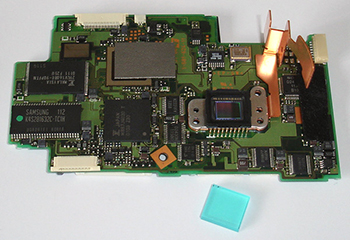
Left - the Sony S75 (a 2001 model) with its screw on filter adapter for a Hoya R72 NIR filter.
Right - the camera's main circuit board with sensor NIR blocking filter removed. Replaced with a blank optical glass plate of similar size.
(At this stage of the disembowelling I wondered if it would ever work again!)
It's some years since I have used it in earnest but a fascinating gallery of NIR imagery by Lynda Laird using film on the BBC News website of WWII Normandy bunkers renewed my interest. So I duly dusted down the camera and carried it on recent regular walks in my local area. These are walks from my doorstep within a few miles both enjoying the gardens in quiet back streets plus the green semi-wild areas that maybe within distance.
This is an image gallery of very familiar features on my walks in near infrared light. One of the appeals of NIR photography is that literally do rediscover oft familiar scenes in a new light and also learn to visualise what scenes are best suited for that lighting.
Image details: Sony S75 3.3 Mpixel 3X Carl Zeiss zoom lens. IR filter removed off sensor, replaced with clear optical
glass plate to maintain autofocus (from Knight Optical UK). Hoya R72 filter on camera. Manual white balance taken off grass (see Appendix on setting a white balance). Colour mode used. AV mode, f5.6 for most with typical exposure 1/250th second.
The high shutter speeds allowing handheld work and the bright live view image are two of the main benefits of converting a camera.
Only tonal balance adjusted (and often quite modestly) where necessary in software post capture.
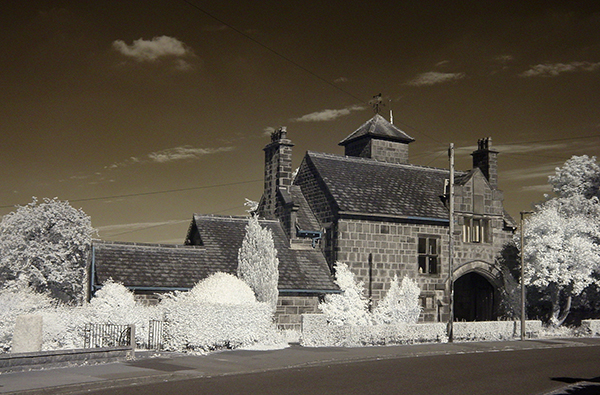
The Gatehouse, Low Hills Lane, Huddersfield. By leaving the camera in colour mode some subtle colours are seen, the sepia tint in the sky and some blue in the guttering. Green foliage which reflects NIR well adopts various shades of white to grey. Stonework and the sky
are much darker giving high contrast imagery.
This attractive property with oodles of character is a few minutes walk from my much humbler abode in an adjacent avenue. In its present setting it seems rather incongruous surrounded by modern bungalows and two storey housing. A leaflet by the Huddersfield Historical Society online states that it was built in 1900 by a noted local architect, Edgar Wood but the main building
was never built. The archway retains a pair of substantial wooden doors. The property looks at its best for photography in the early evening, as shown here, when the sun lights up the front.
This property as did many of that era for obvious reasons, exploited the local stone, a millstone grit. This approach is sadly lacking for the modern bland housing estates currently being built by the big conglomerates on Lindley Moor a mile or so away.


Salendine Nook Baptist Church and graveyard. The church website notes that the original building dates back to the 18th century but was later extensively updated. In addition
to its traditional roles the buildings are used for a wide variety of activities for the community. The churchyard is a short walk from my home and with its high walls isolating it from the urban surroundings I find it a pleasant sanctuary from the busy traffic on an adjacent main road. Graveyards are often left unattended in some areas allowing wild flora and fauna to
make use of it.
The church website has some splendid images of the church from presumably a drone. A NIR adapted camera attached to a drone seems to offer a lot of potential for many scenes.
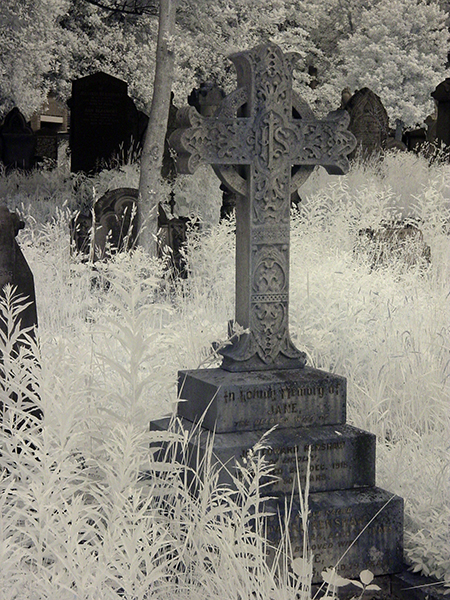
Another appeal of churchyards is the wide variety of styles of gravestones, their opulence perhaps providing some insight into the wealth of the family with the many and varied inscriptions.
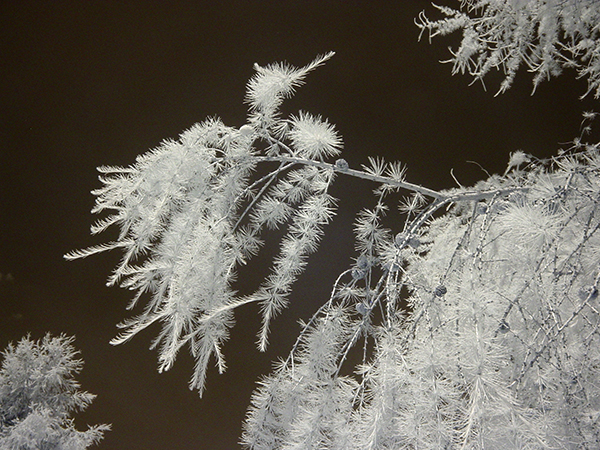
Fern Lea wood, Huddersfield. In
mid-June the trees are in full leaf so more of a challenge to isolate images of interest. Seeking out forms against the sky is one approach and an example is shown. NIR is especially suited as creates excellent contrast between the darkened sky and lightened foliage. My brother Ian pointed out that it looks somewhat like a very spiky bird!
Although I have lived for over twenty years in Huddersfield, the keen urban rambler can benefit from buying the local large scale map (or
inspect the online equivalent) as possible walking spots could be overlooked. I was aware of a
managed recreation ground at Fern Lea but not the quite extensive wood with a number of paths adjacent to it which Ian first stumbled upon. Being 10
minutes from our home
this is now a regular haunt at all times of year with the attractive range of trees, open glades and associated fauna and flora.

Fern Lea wood, Huddersfield. Looking down onto the managed recreation ground from the higher wood. The housing estate adds some extra contrast. I live in the estate behind the one shown.

Fern Lea wood, Huddersfield. An attempt to make use of the playing field structures to contrast against the foliage and sky.
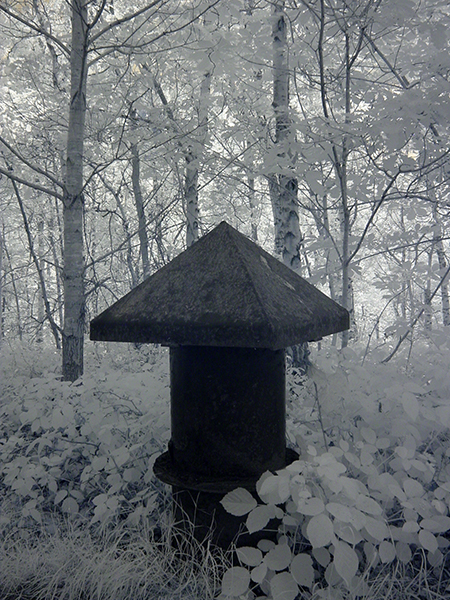
Fern Lea wood, Huddersfield. Understorey imagery is likely better in late Spring when the earlier leaf growth allows more striking lighting. This was a better attempt but still rather muddy tonality compared with the earlier shots. I'm uncertain of the history of this wood but a number of ventilation cowlings as shown suggest it may have been planted on either disused underground workings or a now covered rubbish tip.
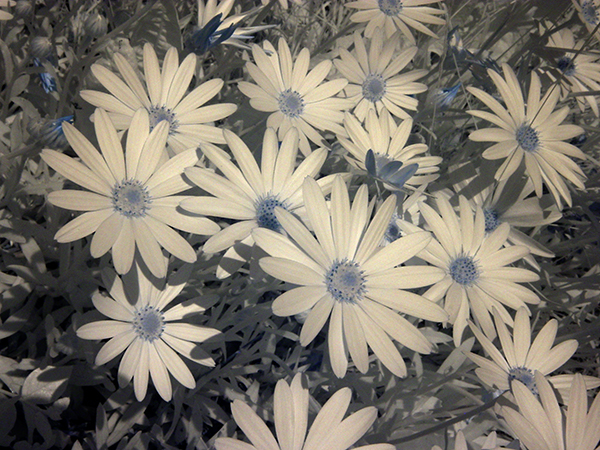
Pink daisy flowers in own back garden. Expert practitioners of NIR photography have shared striking imagery of plant close-ups but have not been too successful to date. The original was very flat and required more tonal balance correction to improve. A careful choice of strong plant shapes against a darker background would work betterófor example an isolated clump of ferns against a local drystone wall. The flower anthers show a hint of blue in NIR.
Comments to the author David Walker are welcomed.
Appendix. A note on white balance
After first converting the S75 in 2010 for NIR, I'd naively assumed that would have to accept the red channel dominance, requiring conversion to monochrome and tonal balance adjustment to bring back reasonable contrast. Since writing the article I have bought a copy of Digital Infrared Photography by Deborah Sandidge (Wiley's 'Photo Workshop' series, USA, 2009).
This book has proved invaluable and pointed out a step for white balance correction that on reflection was obvious! For the converted camera with NIR filter on, the camera can be pointed at green grass in sunlight which is essentially white, then set manual white balance. This completely removes the red channel dominance for an essentially monochrome image. This gives more contrasty imagery out of camera illustrated by the view out of my front window below.

Converted camera, R72 filter using colour mode and auto white balance. The red channel is nearly saturated.
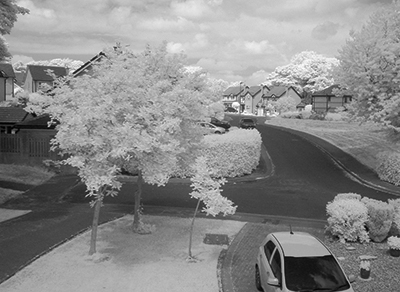
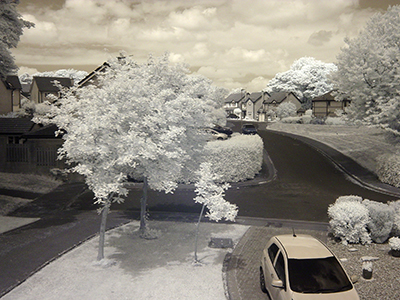
Left. The red image converted to monochrome and tonal balance adjusted. An acceptable image but lacks a good
tonal range and muddy midtones.
Right. R72 filter using colour mode but manual white balance on green grass filling the frame in sunlight. Minor tonal balance adjustments. A much better range of tones and by leaving in colour mode, gain subtle tones in the sky and in this case for the neighbour's red car.